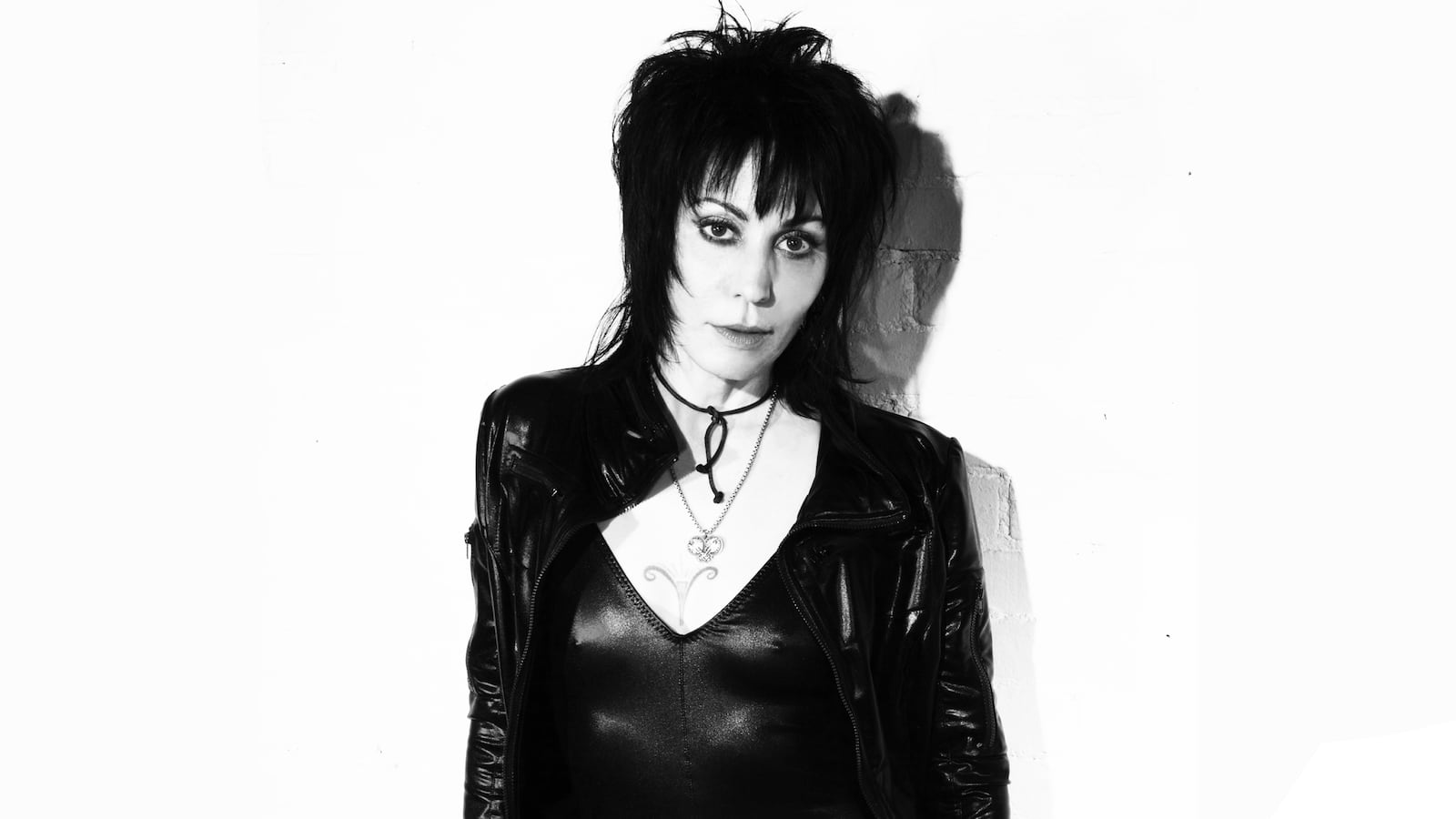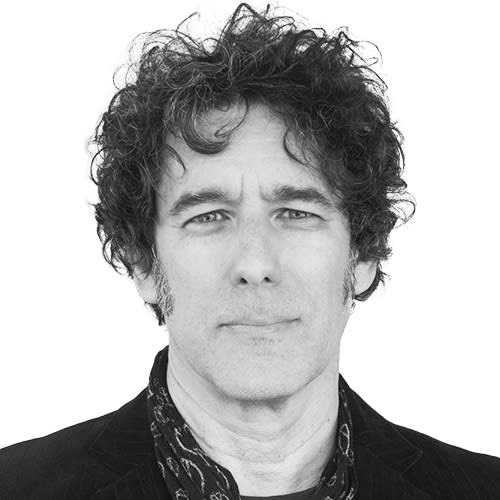“Yeah? What is it? Tell me!” Joan Jett demands, followed by a hearty laugh, when I tell her that when my kids recently saw her as the opening act for The Who, not having previously heard of her, they came away firm fans. “It’s amazing to see and feel that from the stage, but that’s so cool to hear.”
She’s been called the Queen of Rock and Roll, not to mention the Godmother of Punk. But really, Joan Jett is a survivor.
“It’s exciting, it’s gratifying, and it’s something that you can’t really manufacture,” Jett continues, reflecting on her newfound status as a rock and roll legend, playing to ever-larger crowds on a seemingly never-ending tour. “Either people are into it or they’re not. But I do find the makeup of the audiences now—and for probably a good 10 years—has become all ages, and people who clearly like all styles of music, because I see everyone out there from hippies to punks.”
Jett’s story is, of course, the stuff of legend. She survived the fractious rise and fall of her first band, the Runaways—recently chronicled in both a documentary and feature film—as well as her meteoric ascent in the early 1980s to the ranks of rock and roll’s elite, at the hands of the then-fledgling MTV. That was, of course, followed by an equally speedy fall, courtesy of changing times and more than a little sexism—even from her own label—only to become a beacon of authenticity and an icon to the LGBT community (“I stand with everybody,” she says, proudly) in this decade.

“It’s a word that’s probably over-used today—authenticity—but I still think people are looking for it,” Jett says. “They’re looking for something that’s real, because we have so much fakeness today. Everything nowadays is always about putting this best face forward—or phony face forward, as far as I’m concerned—with people creating their ‘brands’ online. I’m talking about little kids, even, and definitely teenagers; everybody’s got a brand. So when people see something they sense is authentic, they gravitate to it.”
One of the most iconic artists of the 1980s MTV era, Jett’s story was retold in last year’s career-spanning documentary Bad Reputation. It’s a remarkable tale: Jett, aided by ever-present manager Kenny Laguna, building her career by fusing punk and glam and the sort of old school rock and roll that used to pepper the AM airwaves in the 1960s, along the way embracing the music videos that MTV was in desperate need of, becoming a household name in the process. But it had been a long, hard road already.
As a kid growing up in suburban Pennsylvania, Jett had absorbed every Black Sabbath, David Bowie, T. Rex, and New York Dolls record she could get her hands on. By her late teens, she was never without a guitar, and had relocated to Los Angeles and co-founded the pioneering all-female band the Runaways.
“I know some of the others in the band have negative feelings about those days,” Jett says, no doubt referring to her former bandmates’ horror stories about their then-manager Kim Fowley. “I don’t. But those were hard times, that’s for sure. So much of the time it just felt like we couldn’t catch a break.”
While the band didn’t last long, Jett soon joined forces with Laguna, who would go on to become a member (and producer) of her group the Blackhearts. On the heels of a 1980 solo album—which took more than a bit of its swagger from early Ramones records—Jett and the Blackhearts had a template for chart domination. “Bad Reputation,” “Do You Wanna Touch Me (Oh Yeah),” and 1982’s breakthrough album I Love Rock ‘n Roll soon followed, with the then-nascent MTV giving the charismatic Jett and company just the edge they needed in the competitive post-punk era.
A cover of Tommy James and The Shondells’ “Crimson and Clover” soon hit the Top 10, as did the brash power-pop “I Hate Myself For Loving You,” and ensured that Jett would be a household name for years to come.
“Always the coolest person in the room, and an inspiration to anyone who feels like an outsider or misfit,” Jett’s biography reads on her Hall of Fame inductee page. It’s a great line that also sums up Jett perfectly.
But the 1990s and ‘00s were hard years for Jett, who toured and recorded relentlessly during those decades, even when it seemed no one cared.
“I think I’ve always been more of a live performer,” Jett says of her long climb back. “Rock and roll shows were always, for lack of a better way of phrasing it, a young person’s game. So you have to rectify those things as you get older. Is rock and roll still relevant to an older person? I say absolutely yes!”
“But how do you continue doing it as you get older?” she continues. “I think we’re just staring to figure that out. I like to make records, and I like to write songs; it’s more or less finding subject matter, and finding how to change the approach as I get older. Because if you write about really deep, heavy things, some people might tune out. So that’s the challenge. And it’s one of those things that we are all—all artists—just trying to figure out, because I do really want to write about real things.”
During those lost years, Jett, a rock and roll pioneer as one of the few instantly recognizable women in the genre, became a tireless advocate for young artists, building relationships with a long list of up-and-comers, including Miley Cyrus, who inducted her into the Rock & Roll Hall of Fame, as well as Green Day’s Billie Joe Armstrong, and Foo Fighters’ Dave Grohl. As she climbed her way back from what at the time seemed like career oblivion, she became a model for younger artists, as the standard-bearer for the old-school belief that uncompromising independence is the only way to survive—and succeed—in rock and roll.
“It’s all ages,” Jett says of her shows these days. “I guess I can’t really use one descriptive word to sum them up, except for ‘music lovers,’ really.”

Inductee Joan Jett speaks onstage during the 30th Annual Rock And Roll Hall Of Fame Induction Ceremony at Public Hall on April 18, 2015, in Cleveland, Ohio.
Mike Coppola/GettyThe rise of women in rock, in particular, is something that she no doubt takes pride in.
“The music business feels like the last place to be affected by #MeToo,” Jett says, more than a hint of frustration in her voice. “My parents told me I could do anything, and I never let anyone get in my way. But it is exciting to see lots of young girls and young women in the audience, and to know that there’s more of us now in the music business than ever before, because that’s really the only way things will change. I mean, nothing is going to change until it’s forced to.”
So how does she feel that the guitar manufacturer Gibson will soon release its third guitar modeled on one of Jett’s iconic instruments, and that the Melody Maker guitar she wielded so fiercely on the cover of her early albums currently sits in the Metropolitan Museum of Art’s new exhibition “Play It Loud,” next to the guitars of Jimi Hendrix, Jimmy Page and Eric Clapton?
“I chose my guitars, initially, because they were all I could afford,” Jett says wryly of the honor. “But I totally relate to that fan thing—of wanting to see and play the guitars your favorite artists played. But I’ll tell you, I didn’t really key in to my favorite people—Marc Bolan, David Bowie—necessarily using specific guitars. Honestly, it was what I could get my hands on. But for some reason, I knew I wanted a Gibson and not a Fender. I don’t know what that was about, and I don’t really know where that came from.”


